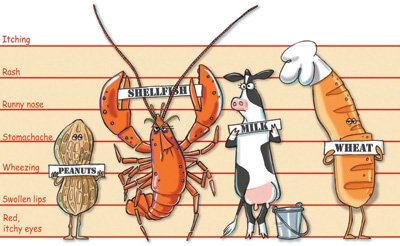As a population, Americans are becoming more allergic, and
scientists don’t know why.
The incidence of food allergies has skyrocketed, doubling in the
last 10 years. One in 25 Americans has a food allergy, and for
children younger than 3, the ratio is 1 in 17.
As a population, Americans are becoming more allergic, and scientists don’t know why.
The incidence of food allergies has skyrocketed, doubling in the last 10 years. One in 25 Americans has a food allergy, and for children younger than 3, the ratio is 1 in 17.
“All types of allergies are increasing,” said Anne Munoz-Furlong, the founder and CEO of the Food Allergy & Anaphylaxis Network.
A food allergy occurs when the body’s immune system mistakenly attacks the proteins in a particular food, releasing chemicals that cause symptoms that can include hives or gastrointestinal or respiratory distress. Symptoms, whether mild or severe, occur quickly, within a few minutes to two hours of eating. In the most severe cases, they progress to anaphylaxis, a potentially fatal condition in which the allergic reaction overtakes the entire body, according to the Food Allergy & Anaphylaxis Network.
“We’ve done such a good job eliminating childhood diseases that we grew up with that our immune systems are looking for something to do. We don’t understand why our immune system selects one food over another,” Munoz-Furlong said.
Allergists say any food can cause an allergic reaction, but 90 percent of the time it’s one of the “big eight” foods – milk, eggs, wheat, soy, peanuts, tree nuts (almonds, cashews, pecans, pistachios, walnuts), shellfish (shrimp, crab, lobster) and fish (tuna, salmon, catfish).
Some health professionals think that food allergies are increasing because we’re all exposed to more of the “big eight” allergens through processed foods.
“As soon as you stray into the aisles of prepared and processed foods, life becomes much more complicated,” said Alice Sherwood, whose son is allergic to eggs and nuts.
Sherwood wrote “Allergy-Free Cookbook” because allergy-free food was something she couldn’t find when she needed it. Although there are 12 million Americans affected by food allergies, there aren’t many allergy-friendly products on the market, she said.
For the cook, four of these food groups (gluten, eggs, nuts, dairy) are particularly difficult to avoid because they are used in so many dishes. Research shows that most people are allergic to only one or two foods. In her book, Sherwood chose to develop alternative versions of each recipe to cater to each of those four food allergens. Each recipe has versions that are free of gluten, dairy, eggs or nuts.
Children with food allergies, and their parents, always have to be on guard to prevent a reaction.
“The best defense is education,” Munoz-Furlong said. “Learn what the symptoms are, and talk to your doctor and get a diagnosis.”
The only way to prevent an allergic reaction, Munoz-Furlong said, is by strictly avoiding the food.
What is a food allergy?
It is a condition in which the immune system incorrectly identifies a food protein as a threat and tries to protect the body by releasing chemicals into the blood. The release of these chemicals results in the symptoms of an allergic reaction.
What are the symptoms?
A reaction might begin with a tingling sensation, itching or a metallic taste in the mouth. Other symptoms can include hives, a sensation of warmth, wheezing or other difficulty breathing, coughing, swelling of the mouth and/or throat, vomiting, diarrhea, cramping, a drop in blood pressure and loss of consciousness. These symptoms might begin several minutes to two hours after exposure to the allergen, but life-threatening reactions can get worse over several hours.
What is anaphylaxis?
Anaphylaxis is a serious allergic reaction that occurs rapidly and can cause death. It can be caused by food but also by bee stings, drugs and latex. In the United States, food allergy is the leading cause of anaphylaxis outside the hospital setting and is responsible for an estimated 150 to 200 deaths and 30,000 emergency room visits a year. The symptoms of anaphylaxis can include any of those associated with an allergic reaction to food. Studies have shown that early administration of epinephrine (adrenaline) is crucial to successfully treating anaphylactic reactions. Epinephrine is available by prescription in a self-injectable device (EpiPen or Twinject).
Who is at risk?
Research suggests that having asthma in addition to a food allergy increases the risk of a severe reaction, and teens and young adults who have peanut or tree-nut allergies in addition to asthma are at the highest risk.
Facts
– Approximately 6.9 million Americans are allergic to seafood, and 3.3 million are allergic to peanuts or tree nuts (reliable figures aren’t available for the other common food allergens).
– About 3.1 million children in the U.S. have food allergies. Many of these children will outgrow their food allergies.
– According to studies conducted by the Food Allergy & Anaphylaxis Network (FAAN), peanut allergies doubled in children between 1997 and 2002.
– In the U.S., food is the leading cause of anaphylaxis outside the hospital setting.
– There is presently no known cure for food allergies.
– Even trace amounts of a food allergen can cause a reaction. And allergens don’t have to be ingested to cause a reaction; skin contact or inhalation also can trigger it. According to research conducted at Mt. Sinai hospital in New York, people should wait at least four hours after consuming a food allergen before kissing someone who is allergic to that food.
– A FAAN review of food allergy fatalities found that most of the people had never had a severe allergic reaction until the one that caused their death.
– Scientists don’t know why allergies are increasing. One theory holds that because children in our culture are exposed to fewer germs, the immune system, deprived of its customary full-time germ-fighting job, misidentifies certain foods as harmful.














